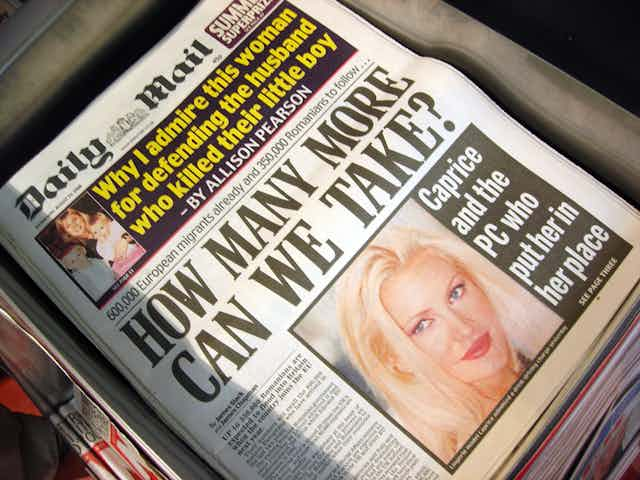Reports of the decision made by some Swiss towns to ban asylum seekers from public spaces are depressingly familiar here in the UK. So too were the recent comments from Roman Staub, mayor of the town of Menzingen, who stated asylum seekers should be banned from “sensitive areas” such as the vicinity of a school. He said: “This is certainly a very difficult area, because here asylum-seekers could meet our schoolchildren - young girls or young boys.”
The not-so-subtle subtext here is easy to decipher. Asylum seekers have become, in effect, the bogeymen of folk tales.
Unfortunately, it is this image of the asylum seeker – as outsider, invader and criminal – that has been a staple feature of the tabloid representation of asylum over the past 15 years or so. For the right-wing tabloid press in Britain the greatest threat to the social fabric of Britain is the continual influx into the country of asylum seekers and illegal immigrants.
The same old story
Barely a week passes without reports of asylum seekers casually entering Britain. They are, we are told, seduced by the lure of state offered riches, superior housing and a life of luxury. The consistent point is that Britain is too full and cannot afford the cost of hosting so many asylum seekers applying for refugee status.
A great deal of media attention focuses on numbers and cost to the taxpayer. Given the level of animosity, and the sheer amount of coverage, it is fair to say that (for sections of the British press) asylum seekers and refugees have become the latest in a long line of what Stanley Cohen defined as “folk devils”.
According to Cohen, certain minority groups become the subjects of moral panics. These are people who are perceived to exist apart from the core values of consensual society and are therefore a risk to the continued existence of accepted norms. The media, and in particular the press, have been instrumental in the demonisation of refugees, whipping up hysteria whilst calling for tighter immigration controls.

One of the stereotypes that clearly emerges is of unwanted and threatening outsiders in British communities. Though the relationship between public opinion and media coverage is a complex one, what is evident from various studies of coverage of asylum seekers and refugees is the fact that the population of Britain is presented, via its right-wing press and television news, with coverage that is one dimensional, repetitive and alarmist.
Strong views
When Lord Justice Leveson submitted his report into the ethics and practices of the press in November 2012, he stated:
When assessed as a whole, the evidence of discriminatory, sensational or unbalanced reporting in relation to ethnic minorities, immigrants and/or asylum seekers, is concerning. The press can have significant influence over community relations and the way in which parts of society perceive other parts. While newspapers are entitled to express strong views on minority issues, immigration and asylum, it is important that stories on those issues are accurate, and are not calculated to exacerbate community divisions or increase resentment.
The situation in 2013 is little better. As I write, I take a trip to the Daily Mail website and find that in July the paper ran stories under these headlines:
-
Park Lane gipsies sent packing: Police swoop on camp in central London and offer Roma free flights home (but only if they fancy it)
-
Defunct UK Border Agency paid out £13m in a year for legal costs in immigration cases it lost
-
True toll of mass migration on UK life: Half of Britons suffer under strain placed on schools, police, NHS and housing.
And from the Daily Express:
- EU flooded with 1,000 asylum seeker applications EVERY day.
-
Fury at £32m bill to care for failed asylum seekers
This sort of reporting matters a great deal because, obvious though it may be, research tells us that the media is the most important and powerful force that helps shape public opinion about “controversial” issues such as immigration and asylum.
It’s no wonder, then, that there is a vast disparity between what the British public believes to be the state of the nation, and the actual reality reflected by sober statistics. Average estimates of the total immigrant population were found to be two to three times higher than reality.
The other side
I don’t think anyone could deny that there are problems with the UK government’s policies toward immigration and asylum. What we need to do debate these issues calmly and rationally without resorting to hysteria and scare mongering.
What if the Mail, Express and the Sun told us that almost all asylum seekers are not allowed to work and are therefore forced rely on state support which can be as little as £5 a day? What if they told us, on their front pages, that crime levels in neighbourhoods that have experienced mass immigration from eastern Europe over the past 10 years has fallen significantly?
And what if they actually appealed to our basic humanity? What if they concentrated on the underlying reasons for asylum seeking – the suffering and misery endured by people forced to flee their home countries? Well, that certainly would be news. News beyond the continual repetition of a few insidious, odious themes.

